Third Annual Roundtable Canada's Platform for Disaster Risk Reduction
Table of contents
- Letter from the Advisory Committee
- Canada's Platform Overview and Evolution
- Agenda at a Glance
- Summary of Proceedings
- Welcome
- Canada's Platform: The Year in Review
- The Working Groups: Building on Our Successes
- Talk-Show: From Reaction to Resilience
- The Future of Disaster Risk Reduction
- Breakout #1 - Private Sector for Disaster Resilient Societies:
- Breakout #2 - Potential of Communities and Networks:
- Breakout #3 - National Governments, Provinces and Local Authorizes Securing Sustainable Risk Management:
- Breakout #4 - Disaster Risk Reduction in Canada:
- Breakout #5 - Adapting to Climate Change:
- Mobilizing Public Awareness to Engagement
- Conclusion
- Messages from the Third Annual Roundtable
- Annex A
Letter from the Advisory Committee
The Advisory Committee for Canada's Platform for Disaster Risk Reduction is pleased to present you with the final report for the Third National Roundtable on Disaster Risk Reduction held in Vancouver, British Columbia, on October 23, 2012. The Roundtable is the means through which the Platform membership communicates its views, perspectives, concerns and priorities on disaster risk reduction issues. The Advisory Committee uses this report to identify priorities and potential linkages among DRR activities and to help inform the working groups under Canada's Platform.
Canada's Platform is maturing and we are pleased that interest in the Roundtable continues to grow. The diversity of professionals and individuals with an interest in disaster risk reduction enriches our national perspective and strengthens our ability to advance the work of Canada's Platform. Participants at the 2012 Roundtable represented various areas such as industry, utilities and the private sector, science and academia, emergency management associations and organizations, all levels of governments from federal to municipal townships, volunteer and emergency response organizations, and international partners.
We would like to thank everyone who attended and participated in this Roundtable event. We hope that the Roundtable was a useful forum for participants to express their views and that this report is an adequate and fair representation. We encourage all stakeholders and partners to continue to pursue the priorities set out in this report and to work together in keeping Canadians safe and resilient to disasters.
We would also like to thank the volunteers who have made this on-going work successful, especially the Chairs and members of the four Working Groups; these individuals have demonstrated leadership and a commitment to disaster risk reduction.
We look forward to seeing you at the Fourth Annual Roundtable to be held in Regina, Saskatchewan, on November 5, 2013.
Sincerely,
Canada's Platform Advisory Committee
Serge C. Beaudoin (co-chair)
Ernest MacGillivray (co-chair)
Mark Baker
Francis Bradley
Louise Geoffrion
Ron Kuban
David McCormack
Laurie Pearce
Rodney Yip
Ian Burton
Canada's Platform Overview and Evolution
January 2005
168 Governments, including Canada, adopted the Hyogo Framework for Action (HFA), under the United Nationals International Strategy for Disaster Reduction (UNISDR). The HFA is a non-binding international guidance tool which seeks to reduce the human, social, economic and environmental costs of disasters. The HFA created three strategic goals and five priorities for action.
HFA Strategic Goals:
- The more effective integration of disaster risk considerations into sustainable development policies, planning and programming at all levels, with a special emphasis on disaster prevention, mitigation, preparedness and vulnerability reduction;
- The development and strengthening of institutions, mechanisms and capacities at all levels of government, in particular, at the community level, that can systematically contribute to building resilience to hazards; and
- The systematic incorporation of risk reduction approaches into the design and implementation of emergency preparedness, response and recovery programs in the reconstruction of affected communities.
HFA Priorities for action:
- Ensure that disaster risk reduction (DRR) is a national and a local priority with a strong institutional basis for implementation;
- Identify, assess and monitor disaster risks and enhance early warning;
- Use knowledge, innovation and education to build a culture of safety and resilience at all levels;
- Reduce the underlying risk factors; and
- Strengthen disaster preparedness for effective response at all levels.
June 2009
As part of its commitment to deliver on the HFA, Canada announced the establishment of a National Platform for Disaster Risk Reduction to build multi-stakeholder coordinated leadership in DRR. Canada's Platform has been organized to comprise four interconnected components: an Advisory Committee; general membership; working groups; and a secretariat, which is housed at Public Safety Canada. The four components of Canada's Platform convene annually at the National Roundtable on Disaster Risk Reduction, which serves as a venue for Canada's ongoing national dialogue on DRR, the administrative annual general meeting for the Platform, and an opportunity for deliberative dialogue among DRR stakeholders.
October 2010
The inaugural National Roundtable was held in Fredericton, New Brunswick. Over 70 participants attended from across public, private, academic, volunteer and non-government sectors.
Roundtable 2010 Objectives:
- The launch of Canada's Platform for Disaster Risk Reduction.
- Discussion of the vision for Canada's Platform and identification of priorities and action areas for collaboration.
- Inclusive horizontal and participatory dialogue with DRR stakeholders in Canada.
- Confirmation of Canada's Platform Advisory Committee.
Roundtable 2010 Highlighted Outcomes:
- An open, inclusive forum where DRR stakeholders from many disciplines were able to liaise and contribute as a community to the future of DRR in Canada.
- Agreement on four priorities on which to focus in the way forward for the Platform:
- Strengthening National Leadership for DRR.
- Increasing Engagement of DRR Stakeholders.
- Fostering DRR Research and Knowledge Exchange.
- Demonstrating Value and Accountability in DRR.
October 2011
The Second National Roundtable took place in Ottawa, Ontario and participant numbers increased to 142. Aims and Objectives for Canada's Platform were established to guide the way forward and inform the planning of the Second Roundtable.
Canada's Platform for Disaster Risk Reduction Aim:
To make Canadians safe by reducing risks, by making communities more resilient and by partnering with all levels of government, universities, professional associations, voluntary organizations and the general public.
Canada's Platform for Disaster Risk Reduction Objectives:
To reduce risk, vulnerability and impacts of natural and non-natural disaster to Canadians; provide a coordinating mechanism for disaster risk reduction across sectors; and support stakeholders with relevant knowledge and information.
Roundtable 2011 Objectives:
- Continue to pursue highlighted priorities identified at the 2010 inaugural Roundtable, including engaging the DRR stakeholder community in a national dialogue.
- Pursue aims and objectives set out by Canada's Platform.
Roundtable 2011 Highlighted Outcomes:
- Seven cross-cutting themes emerged relevant to the Platform advancing its goals.
- The need for continued support in bringing DRR stakeholders together enabling increased participation and collaboration in DRR.
- Importance of leadership and DRR champions to create the social and political moment necessary to move the DRR agenda forward.
- Importance of transferring knowledge and sharing information, especially with communities with limited resources.
- Community-based approach to DRR incorporating local knowledge and partners.
- Promotion of resilient communities as those able to resist, absorb, accommodate, recover and spring back from a disaster.
- Need for people, communities and other stakeholders to be engaged, enabling the development of local and national networks or virtual communities sharing information to reduce risk.
- Role of the private sector in providing incentives encouraging good prevention and mitigation practices.
October 2012
The Third Annual Roundtable took place in Vancouver, British Columbia. The aim expressed during 2011 Roundtable has now been articulated as Canada's Platform Vision. The seven themes set out in 2011 guided the 2012 Roundtable objectives and priorities, which continue to pursue the four priorities set out in 2010. Interest in the Roundtable has continued to expand with some 200 people participating in person and numerous others participating virtually for the Talk Show segment of the Roundtable.
Canada's Platform Vision:
A safer and more resilient Canada through the reduction of risks and, leveraging of capacities and opportunities across all levels of government, non-governmental organizations, private sector and academic sectors and the general public.
Roundtable 2012 Objectives:
- Work in an integrated manner to reduce the risk, vulnerability and impact of natural and non-natural disasters to Canadians.
- Provide a coordinated mechanism for cooperation and information sharing between sectors and existing networks.
- Support stakeholders with relevant policy, program and research information at local, regional and national levels.
Roundtable 2012 Priorities:
- Strengthen and support national level leadership for DRR.
- Increase national understanding of and engagement in DRR.
- Expand knowledge and capacity on disaster mitigation and resilience.
- Develop corporate planning for Canada's Platform for Disaster Risk Reduction.
The working groups are key to advancing the vision of Canada's Platform. With the guidance resulting from participant discussions and input during Roundtable 2012, the working groups will continue to focus efforts in pursuing identified objectives and priorities in 2013.
Agenda at a Glance
| Timing | Activity |
|---|---|
7:30 – 8:30 |
Registration |
8:30 – 8:45 |
Traditional Welcome |
8:45 – 9:00 |
Welcome
|
9:00 – 9:05 |
Opening Comments |
9:05– 9:15 |
Canada's Platform: The Year in Review |
9:15 – 10:15 |
The Working Groups: Building on our successes |
10:15 - 10:30 |
Health Break |
10:30 – 12:00 |
A Talk-show of different perspectives; From Reaction to Resilience
|
12:00 – 13:00 |
Lunch |
13:00 – 13:15 |
Canada and the International Community: The Future of Disaster Risk Reduction |
13:15 – 14:45 |
Concurrent Sessions: The Future of Disaster Risk Reduction |
14:45 – 15:00 |
Health Break |
15:00 – 16:15 |
Mobilizing Public Awareness to Engagement
|
16:15 – 16:30 |
Concluding remarks
|
17:00 |
Social Event for all participants (CHRNet Sponsor) |
Summary of Proceedings
Welcome
Mr. Victor Guerin, an Elder from the Musqueam Nation, welcomed the Roundtable participants to the Musqueam traditional ancestral territory. Mr. Guerin reflected on the importance of DRR and blessed the conference and the participant's DRR efforts in both native and English tongues. He captivated the audience with traditional song and drums that set the tone for the roundtable.
Minister of Justice and Attorney General Shirley Bond thanked Mr. Guerin on behalf of Roundtable participants and welcomed special guests and the entire delegation of participants. Minister Bond expressed pride in her role as the lead emergency manager for British Columbia (B.C.) and emphasized the need for cross-sectorial collaboration in disaster management and the importance of social media in Emergency Management (EM). Minister Bond noted the use of “Twitter” in this year's Roundtable and called this technology a simple yet powerful tool. Minister Bond took the opportunity to highlight the success of the recent "Shake-Out" earthquake simulation exercise that had taken place in Vancouver, B.C., and given B.C.s extensive 57 known hazards, stressed the importance for all individuals to accept their role in disaster management and to take responsibility for their, their family and their community's success in a disaster. Minister Bond praised the volunteer sector for its role in disaster management and referred to her upcoming announcement that would formalize a collaborative partnership between the Government of B.C. and the Canadian Red Cross. In closing, Minister Bond stressed that all Canadians should feel assured that their governments are doing their best to keep them safe.
Canada's Platform: The Year in Review
The co-chairs of the Advisory Committee to Canada's Platform, Serge C. Beaudoin and Ernest MacGillivray, addressed the audience with an update of the year in review. Among the accomplishments of the past year included the development of a five-year action plan for the Platform, outlining activities and priorities for the Advisory Committee, the working groups, as well as the Platform secretariat. The co-chairs highlighted a way forward focused on broad participation and specific projects that empower individuals, communities and the private sector to be more ready for a disaster. This led to the next Roundtable program segment meant to elicit views from the membership on future working group activities and inform more detailed planning of these activities.

Image Description
The above image is a slide, entitled “Canada's Platform for Disaster Risk Reduction”. There are 3 bullets at the top of the slide. These bullets say “Multi-Stakeholder framework”; “Coordinated, participatory, and interactive process”; and “Utilizes new and existing mechanisms building on areas of common interest”. Below those three bullets is a box with the words “250+ Members” written inside. To the right of that box is an arrow pointing to the right, with four bullets inside. The four bullets say “Advisory Committee”; “General Membership”; “Working Groups”; and “Secretariat”. Below the arrow is a main bullet that says “3 Roundtables hosted”, with 3 sub-bullets, saying “New Brunswick (2010); Ontario (2011); British Columbia (2012).
The Working Groups: Building on Our Successes
Intent
The intent of the working group session was to engage participants in the planning, priority setting and efforts of the Platform working groups. Each of the four working groups, (Private Sector Partnerships; Resilient Communities; Science and Technology; and Voluntary Sector) provided discussion topics in order to obtain the views and comments from the various stakeholder perspectives among Roundtable participants (which form Canada's Platform membership). The feedback from roundtable discussions was recorded and provided to the working group co-chairs to inform their work.
Private Sector Partnerships Working Group
Highlights
The Roundtable participants who engaged in discussions on Private Sector Partnerships provided some firm views regarding the expectations from the private sector in contributing to the resilience of communities. The private sector is frequently responsible for critical resources and expertise that both bolster the response capacity and provide for continuation of societal function. This responsibility is thereby extended to ensuring the survivability of infrastructure and the continuance of the supply chain through strong business continuity planning.
To do this, the private sector needs to be integrated into a holistic approach to planning with the larger critical infrastructure, retail and supply chain players involved in exercises. Key private sector players also need to be included in information networks where industry can gain a better understanding of challenges faced by the EM community and develop and contribute solutions.
Next Steps
In addition to engaging on supply chain and business continuity awareness and information sharing activities, the PSPWG is continuing to outreach to other industry members to join the PSPWG in order to enhance and expand the scope of the PSPWG DRR initiatives.
Resilient Communities Working Group
Highlights
Among the four working groups, the Resilient Communities Working Group (RCWG) has the largest membership and a very robust workplan. Through this session, Roundtable participants provided fulsome commentary on five major issues, including: engagement of community leaders on the United Nations (UN) 10 Essentials for Community Resilience initiative; engagement of rural and local champions to test the Rural Disaster Resiliency Project Virtual Community of Practice; knowledge of land use strategies and best practices; aboriginal resiliency programs and strategies; and disaster resilience awards for urban and rural communities, and youth.
Next Steps
Based on the feedback received and the collaborative efforts of the working group, the RCWG has identified priorities for the 2013 workplan.
Promotion of the United Nations “Getting My City Ready” Campaign
There was widespread support for the 10 Essentials to serve as a basis for assessment for communities; however, few communities in Canada have taken up the challenge to register for the UN Campaign. The RCWG will seek to foster increased support in Canada for the UN Campaign.
Support Disaster Resiliency in Rural Communities
Much of Canada's population lives in a rural environment and rural communities continue to be seriously impacted in many disasters (e.g., flooding). The RCWG will promote and encourage communities to test the Rural Disaster Resiliency Project (RDRP), a web-based hazard, risk and vulnerability analyses tool launched by the Justice Institute of British Columbia.
Development of a Hazards-Based National Land Use Guide
There continues to be situations where people and homes are put at risk because of poor land use policies adopted by local communities. The RCWG would like to support Natural Resources Canada's work on a National Land Use Guide in partnership with a number of other academic and government partners.
Aboriginal Community Resiliency
Many Aboriginal communities in Canada (First Nations, Inuit and Métis) continue to experience low resiliency to natural hazards and are at increased risk of social, communication, and critical infrastructure breakdown. The RCWG would like to support increased resiliency in Canadian Aboriginal communities.
National Awards
The RCWG would like to support the offering of a National Award for excellent achievement in implementation of DRR activities in Canadian communities to help promote disaster resiliency across the country. To further national capacity and disaster resiliency, the RCWG would also like to establish a national award for the engagement of children and youth in DRR.
Science and Technology Working Group
Highlights
Science and Technology (S&T) in DRR is a very broad topic and can range from implementation of science-based advice or methodologies to the development new and innovative technologies that are continually evolving in this knowledge era. The S&T Working Group (STWG) discussion topics revolved around three key areas of focus: a) data; b) the role of S&T; and c) proposed actions. These questions were posed in order to refine expectations for the STWG and provide real parameters for S&T work that will more directly contribute to the DRR efforts of the other working groups and the Platform membership.
As it relates to data about disasters, hazards and vulnerabilities, the feedback demonstrated a desire for a wide range of types, from geospatial data to social media but highlighted a gap in consolidated qualitative emergency / disaster response information, including: response leads and partner contributions; resources accessed/consumed or not available; who did what; hindsight capabilities; lessons learned; impacts of the event on infrastructure, community, society and economy; and what might have prevented the event. Considerations for the use of the data were raised including archival of historic records and forecasting of trends to metrics for response and damage estimates. Access to data and knowledge management (sharing among community) were also identified as important data issues.
As it relates to contributing to DRR and resilience capacity in communities, the participants highlighted the need for: a risk register to improve information sharing; continued efforts to seek interoperability among systems and processes and tools; and the development of strategies for use of evolving technologies and tools. Among the participants, the view of the role S&T plays in supporting DRR is tremendously varied, from evolving life-saving medicine to enhancing hazard detection to use of science-based methods in decision making.
Next Steps
The STWG is using the feed-back from the Roundtable participants to inform a consultation process to guide the work that will best support the working groups as well as the DRR stakeholder community.
Volunteer Sector Working Group
Highlights
The Voluntary Sector Working Group (VSWG) discussion topics revolved around three key areas of focus, a) the role of the sector in promoting personal preparedness; b) the factors which motivate volunteerism; and c) the support required in different sectors to encourage episodic volunteerism in disasters. These questions were posed in order to assist in the development of a work plan for the VSWG.
Discussions regarding the role of the voluntary sector in personal preparedness focused on the need for further engagement of diverse communities and organizations in the development and delivery of personal preparedness messages to their members. The role of organizations traditionally engaged in disaster response, as convenors and ambassadors of community forums in promoting key messages, was also highlighted.
Motivating Volunteerism
Participants identified many factors that drive volunteerism, including:
the desire to help and share knowledge and expertise,
explore opportunities to develop knowledge and skills, and the simple
necessity to survive.
Based on the discussion, it is evident that the full range of motivating factors plays a role in how individuals wish to engage with the voluntary sector.
Discussion regarding supporting episodic volunteerism across sectors brought several points to the forefront. The overall message related to the need to map response capacity against a voluntary sector skills inventory and disaster management needs. By so doing, it was felt that gaps could be identified and corresponding opportunities provided through the engagement of different sectors could be capitalized on and network development could occur. The need for further engagement of employers in supporting volunteerism was highlighted as well as the concerns held by those employers around risk, liability, training and recognition.
Overall, participants consistently highlighted the use of technology to support volunteerism. The need for increased use of social media as an engagement tool was prevalent, as was exploring technology as a means for training potential volunteers and as a means to communicate with them during an event was prominently featured in the discussions. The use of technology in support of the creation of communities of practice among groups with similar interest was also discussed.
Related Volunteer Sector Working Group Activities
Role of the Voluntary Sector in Supporting Personal Preparedness
In 2008, the Canadian Red Cross, through Public Health Agency of Canada funding, worked with a number of national voluntary sector organization, both involved in emergency management and not traditionally involved, on a project linked to the sector's readiness to respond to a health emergency . Through this project, a number of activities were undertaken including the promotion of the GetPrepared campaign and the creation of a service continuity website called “Ready for Crisis”, which is hosted by Volunteer Canada (http://volunteer.ca/content/ready-crisis).
Supporting Episodic Volunteerism
A second study was commissioned by the Public Health Agency of Canada to address specific issues in the management of episodic volunteers during a public health emergency. This study defined the profile of emergency response “episodic” volunteers, outlined the potential role of these volunteers, recommended recruitment, screening, retention and maintenance strategies to enable the building of surge capacity and finally recommended how to enhance existing volunteer resource management databases. The key findings of this report suggest that the best way to engage “episodic” volunteers in emergency management is by integrating them into existing service structure and funnelling them through existing organizations and agencies.
Talk-Show: From Reaction to Resilience
Canada has the capacity to react to emergencies and provide support to communities across the country, but moving from reaction to resilience requires engagement of all sectors of the economy and community. The Talk-Show, moderated by Canadian Broadcasting Company journalist Duncan McCue, explored important concepts about the meaning and reality of resiliency, setting out expectations citizens should have from government, private sector, relief organizations and for themselves. Leveraging the perspectives of a breadth of societal sectors was an important part of this 90-minute panel discussion with renowned leaders and subject matter experts.
Representing the following sectors:
Non-government: John L. Byrne (Director General, Canadian Red Cross)
Federal Government: Graham Flack (Acting Deputy Minister, Public Safety Canada)
Communities: Kevin Ramsay (City Manager, City of Port Moody)
Industry: Kasey Reese (Vice-President, Risk Management and Chief Internal Auditor, TELUS)
International Partnerships: Richard Serino (Deputy Administrator,
Federal Emergency Management Agency, United States)
Mr. Duncan McCue commenced the session by asking the panellists to each explain what resilience means from their perspective. The discussion then flowed with insightful and entertaining commentary from each of the participants. The following themes capture the highlights and key messages of this panel session.
Resilience
Although presented from varying perspectives, panel members agreed that resilience entails the ability to quickly and effectively resist shocks and to return to previous levels of operation, speed recovery or get back to normal life. This also includes providing the support for the people and community to discover their own resilience and capacity themselves.
A Shift in Message
To facilitate resilience, it was argued that public messaging needed to change to the harsh reality of "we won't be there for you". Honest discussion took place recognizing that tax dollars do not necessarily guarantee that federal, provincial or municipal aid will arrive within 72 hours of an emergency for everyone. Communities should be encouraged to take the leadership role in changing public expectations and promoting individual responsibility and involvement in DRR.
Working Together
Recognizing that responsibility does not lay with one person or jurisdiction, the panel enthusiastically supported the whole-of-community approach to DRR. Successful recovery and resilience is dependent on individuals and neighbour helping neighbour, which effectively represents the public and community. With a team approach, it is critical to remember that the most important part of the team is the public. Also, with a team approach, there needs to be a leader who brings stakeholders to the table. People can walk away from a partnership but less so from a team.
That one neighbour helps another neighbour and the community becomes stronger because at the most basic local level, people are accepting personal responsibility and neighbours are helping neighbours.
Richard Serino
Leverage Opportunities and Relationships to Work within the Resource Pool Available
The opportunities available through partnership and teamwork also come with the challenges of ensuring partners are involved. It was expressed that it is absolutely key to be proactive in going out to bring together all the different partners: too often in Canada "we just don't ask". Especially as many groups or organizations may be willing to volunteer and provide resources but are limited by an unidentified process or contact point to help them do this.
Innovative ways of bringing EM to the community need to be considered, such as accessing faith based groups who can approach a community as a collective.
Kevin Ramsay
The EM community is known as an example of collaboration that simply takes action with partners as necessary to get the job done. Leveraging relationships with communities and private enterprise can result in innovative partnerships such as obtaining loans of human capital in the form of company employees in exchange for their EM training.
Make sure your organization as a whole is risk intelligent by ensuring an ongoing process is in place for recognizing hazards and threats.
Kasey Reese
The private sector is enormous, with potential team players from the hospitality industry to biomedicine to technology, and so on. As most disaster funding is spent on recovery, a shift in spending to focus on mitigation and advanced planning could see significant reduction in damages and loss. Both recovery and mitigation need stakeholders, academia and the media to contribute with innovative concepts and solutions. The importance of Web 2.0 technology was highlighted as critical tool for communities to self-organize, however, everyone was encouraged to think about open information and the immense value of collaboration with citizens as well as the private sector to push the limits in developing life-saving systems and tools.
Web 2.0 and the widespread use of technology are forcing a new approach to EM that may prove more valuable than traditional methods.
Graham Flack
...changes are being realized through youth and the generation that is growing up with a new understanding of community responsibility to foster resilience among its members.
John Byrne
The Future of Disaster Risk Reduction
Through afternoon breakout sessions, participants were able to engage with each other on a topic of their choice. The membership provided very rich commentary in the areas of: 1) Private Sector for Disaster Resilient Societies; 2) Potential of Communities and Networks; 3) National Governments, Provinces and Local Authorities Securing Sustainable Risk Management; 4) DRR in Canada; and 5) Adapting to Climate Change.
The membership also provided a baseline expectation of what a resilient Canada should be by considering the core factors that contribute to DRR. Overall, the membership highlighted that the scope of resilience should be reflected at a national level, with shared understanding and awareness about DRR and the individual's responsibility and role in contributing to a resilient society, as well as demonstrating a certain level of personal preparedness. This national state of understanding would be nurtured and reinforced through a family and educational culture shift and supported by financial mechanisms that encourage prevention/mitigation and preparedness to lessen the impact of disasters.
Breakout #1 - Private Sector for Disaster Resilient Societies:
There are many opportunities to leverage the private sector including as incident volunteers, applying business skills to a disaster and deploying / loaning resources and infrastructure for first responders. Moreover, the private sector is positioned to respond quickly in a community as they are already there and have connections that a regional or national government may not have. However, businesses are also vulnerable and need to ensure that they are also resilient and able to not only respond, but recover from a disaster.
Highlights
Having an up to date business continuity plan that is practiced is a critical component of resilient small- or medium-sized businesses.
The private sector is an important role model in reinforcing a culture of resilience by delivering education and programs and through leadership.
Participants who engaged in the Private Sector discussion expressed clear views about the significant impact that the state of resilience of organizations has on the ability for the rest of the community to cope with a disaster. Private organizations were seen to have more flexibility in their approach, whether through dedicating more resources to DRR activities or by engaging partners and reaching out to stakeholders, than do federal or provincial bodies. Having an up to date business continuity plan that is practiced was seen as a critical component of resilient small- or medium-sized businesses. The private sector was also noted as an important conduit to reinforce a culture of resilience by delivering education and programs to employees and families, as well as providing leadership to the community by acting as a role model and supporting community DRR knowledge and activities.
Breakout #2 - Potential of Communities and Networks:
Community participation in DRR is a priority in the HFA. Communities are where people live and within these communities people belong to networks. Schools, hospitals, professional networks and local community groups can all mobilize and help sustain action for disaster risk reduction. Leveraging work already underway and integrating these networks and community groups can drive local resilience and action. Communities, and networks within them, have the potential for concrete action and awareness development for DRR.
Highlights
The breakout session demonstrated that the community has a solid understanding of the wide range of roles the private sector plays in DRR and elicited important ideas about gaps in knowledge transfer and business community network. Several strategies were identified as being critical to the successful adoption of disaster resilience programs in Canada:
The Canadian Disaster Database contains over 1000 disaster events dating from 1900 that have directly impacted Canadians.
- In order to be successful, existing national, provincial, territorial and community-based strategies and resources need to be linked within a common framework. This includes bringing together both Aboriginal communities, emergency management planning organizations and other relevant stakeholders.
- Encourage the documentation of local events/disasters and to share this information (e.g., the Canadian Disaster Database).
- Showcase best practices at the organizational and local government levels.
- Capitalize on social media capacity to promote disaster risk reduction activities.
- Approaches at the provincial and territorial level need to take place to further disaster awareness through school curriculum starting in elementary school.
- Local media need to become aware of and promote the need to adopt DRR initiatives – these initiatives need to transferable to all ages, ethno-cultural backgrounds and should support dialogue across local organizations and associations.
- DRR needs to become engrained in maintaining a positive lifestyle in Canadians – much like the national campaigns against drinking and driving - practicing DRR should become a way of thinking.
- Organizations need to consider new approaches to minimizing disaster risk – organizations and the private sector need to work cooperatively and develop strong partnerships and working relationships.
Practicing DRR needs to be engrained in the Canadian lifestyle and become a natural way of thinking.
As well, it was acknowledged that Canada can contribute a great deal to the global community:
- Canada should continue to share its experience in providing disaster relief and recovery, investing in mitigation and flood risk reduction activities.
- Canada's cultural background supports an approach of neighbour helping neighbour and its diverse meteorological and geographical landscape provides a unique perspective on disaster risk reduction.
Breakout #3 - National Governments, Provinces and Local Authorizes Securing Sustainable Risk Management:
A clear understanding of roles, as well as coordination among jurisdictions, is necessary.
Canada's Platform for Disaster Risk Reduction has promoted DRR as a national, provincial and territorial, and local priority, and has actively encouraged jurisdictions at all levels to identify and understand their risks, and take measures to reduce those risks. With a shared DRR responsibility among various levels of authorities, a clear understanding of roles, as well as coordination among jurisdictions, is necessary.
Highlights
From the three discussion questions, feedback from the membership engaged in this session consistently fell into to three main themes: a) requirement for a coordinated inter-jurisdictional approach in the areas of knowledge management, communications, training and operations; b) requirement for leadership in modernizing legislation, policies and standards, such as building codes; and c) support for citizen-led initiatives. The participants strongly suggested appetite for enhanced inter-jurisdictional cooperation to reduce redundancies and facilitate information sharing thereby strengthening DRR messaging though consistent and aligned leadership. The participants also indicated a desire for a single point of access to a shared repository of information and DRR resources from regional, provincial, territorial and national level perspectives.
Breakout #4 - Disaster Risk Reduction in Canada:
Although Canada's Platform for Disaster Risk Reduction is still in early stages of development, to date there have been three Roundtables, there are four active working groups and participants include all levels of government, academia, aboriginal groups, and private sector, local communities. Successes include reaching new stakeholders, engaging communities in disaster risk reduction activities and promoting cross-sectoral activities. Canada has the opportunity to continue to be a leader in multi-stakeholder/multi-sector engagement in DRR and could provide international leadership in resilience building and input on a post-2015 United Nation's Framework.
Highlights
The participants who engaged in this session took the opportunity to provide valuable input to Canada's Platform, ensuring the voice of the membership is heard expressing views about the success or limitations of the Platform and the direction of DRR activities in Canada.
It is important for the diverse range of stakeholders to come together on DRR issues.
Participants emphasized the importance of the Roundtable and the opportunity for stakeholders from a diverse range of backgrounds and organizations to come together and deliberate concepts in DRR. The Roundtable was noted as a key mechanism to identify and connect with partners and enable sharing of best practices and knowledge among different sectors and communities. The Platform itself was viewed as an indication of Canada's commitment to support DRR activities and a tool for empowering the membership to promote DRR activities in their communities. Participants expressed the desire to stay informed on Platform activities and to see realization and implementation of the DRR concepts and strategies explored through Roundtable 2012.
Breakout #5 - Adapting to Climate Change:
Adaptation involves making changes in our decisions, activities and thinking in response to observed or expected changes. To deal with current and future changes in climate, we need to adapt, reduce potential harm and to take advantage of new opportunities.
Highlights
Session participants reinforced key concepts about the necessity to consider climate change adaptation in the approaches to DRR, mitigation and preparedness. By understanding requirements for adaptation, the impacts of disasters can be reduced through sound strategic planning. As attitudes, environment surroundings and urban and rural infrastructures are slow to adjust, changes to policies and legislations, which may be even slower to amend, need to proactively address future risks brought on by climate change. Adapting to change was also seen to provide opportunity to build-back better, with higher standards, leveraging scientific knowledge to enhance building codes and land use planning.
Strategic planning, adaptation and building back better can reduce the impacts of disasters.
Mobilizing Public Awareness to Engagement
This session was intended to inspire participants to brainstorm and share new ideas about effective DRR outreach and engagement strategies. To set the tone and provide background for the table discussions, three panelists provided an overview of a successful campaign in which they have been involved, highlighting the type of communications issues they deal with from their three various perspectives.
Representing the following organizations:
Public Safety Canada: Theresa Woolridge (Get Prepared Campaign)
Province of British Columbia: Carol J. Loski (Director Flood Protection Program)
City of Vancouver: Jackie Kloosterboer (Emergency Planning Coordinator)
Ms. Woolridge discussed Public Safety Canada's Get Prepared campaign and shared four key lessons learned. First, the importance of the research that was undertaken to establish a baseline on the issue and understand the state of preparedness in Canada. Second, the need to tailor the message to the appropriate groups, whether the focus is on hurricane preparedness on the East coast, earthquake preparedness on the West coast, or messaging addressing needs of seniors, families, school-age children, urban, rural, and other specific communities. Third, the value in creating consistency in the messages delivered to Canadians; sharing resources to obtain better value for dollar; sharing research and expertise; and accessing new networks and distribution channels enabling Canadians to receive information as they go about their daily lives, in their homes, schools, workplaces, shopping and community environments. Finally, stakeholders are now supporting the campaign online and have become influencers.
Next steps include building on their experience, strengthening networks and partnerships and engaging all segments of society in finding new ways to make communities more resilient.
Ms. Loski discussed the introduction of a new social media team in B.C.s Flood Protection Program, that evolved out the Japanese Tsunami and lessons learned out of that incident. From the beginning, the team knew their social media efforts would be focused on alerts rather than advertising. Using alerts opened an exchange of information on a personal level, with users tweeting questions such as "where is the local evacuation centre?", instead of a traditional one-way information flow from municipal government sources. Ms. Loski's team found that being able to provide information in near real-time, the emergency operations centres and local governments were freed up, as they were able to quickly direct individuals to provincial information blogs and internet feeds.
Next stages might include the development of apps, or follow the Australian model of "know the hazard in your area", and investigating opportunities with partners.
Ms. Kloosterboer works with 30 volunteers who teach public education to residents, specifically related to earthquakes. In community centre settings, the City of Vancouver hosts workshops outlining 10 basic steps to preparedness. Interestingly, the recent addition of a new workshop geared toward pet preparedness was considerably better attended than the standard workshops. The City has also started providing workshops for seniors as well as some in Chinese, while volunteers are being sought that speak other languages. These workshops have also been modified to address needs of underprivileged social economic groups in the lower east side of Vancouver, and have proven very effective.
Language, socio-economic condition and pet ownership are all factors in tailoring the message to the need of the community and play a role in capturing attention and making DRR relevant to the individual.
Roundtable Discussions
Participants then addressed three important issues in engagement, including visioning for a public awareness campaign, effective messages for both mitigation and preparedness, and the call to action - what will motivate individuals to step up.
Key findings from the discussions include:
- A real paradigm shift when thinking about DRR and mitigation versus disaster preparedness.
- The community resilience angle needs to be further developed with a clear call to action defined.
- A culture shift is needed to reinforce that all individuals have a role in building community resilience.
- Outreach needs to focus on mobilizing capacity at the community level.
- Individuals need to be empowered to get involved, but resilience comes from the whole community.
It is up to all of us to be a role model by living and promoting a culture shift and reinforcing community resilience from within.
Leveraging Social Media and Web 2.0 to Build Community Resilience
In this session, the entire delegation was encouraged to provide concrete suggestions for tools that should be considered to promote public awareness and engagement spanning from individual preparedness to community resilience. The following table notes these suggestions in order of frequency.
Over 10 references
Social Media
8-9 references
Twitter, Facebook
6-7 references
YouTube, Traditional Website, Television advertisements (federal and local)
3-5 references
Gaming, Ushahidi, Educational System, Google (including maps), LinkedIn, Blogs
2 references
Pinterest, Flashmob (not just dancing), Story Telling/ Personal Experience, Cartoons, Youth as Messengers
Other suggestions...
National Public Alerting System, Aboriginal Television Network, Libraries, Wikipedia, Situational Awareness Sites, Flicker, Flashmob “Skit” involving responders, Press releases, Crowd Sourcing, Pop-up Websites Ads, Community Events/Gatherings, Texting, Geographic Information/tools & alerts being made publically available, Open Source Tech Content Accelerators - with detailed tracking of all clicks, Radio Billboards, Inserts in mailings from household utilities or city tax assessments, Tumblr
The membership also provided input on associated challenges related to the use of social media, including credibility issues, resource issues (in time and people able to keep up with changes to technology and content), the nature of the media itself being a vast sea of information and the large but exclusive audience being reached. The input also flagged government barriers such as political risk aversion, potential legal liabilities regarding accuracy of information and the need for controlled messaging (which generally detracts from the desirable real-time quality of social media). Lastly, the comments warned of dependency on technology that is subject to failure.
Conclusion
The Roundtable concluded with an announcement of the results from the elections of the four rotating membership seats on Canada's Platform Advisory Committee. Closing remarks provided the membership with the opportunity to reflect on the discussions of the day and, drawing on the presentations, the Talk-Show, the working group discussions and the topic-specific breakout sessions, to communicate their views on a final piece of advice.
As Canada's Platform continues to move forward with implementing its vision, aim and objectives for DRR, with the support and active participation of the membership and the working groups, it will consider the informed and creative advice stemming from the Third Roundtable and its participants.
Annex A
The following are the results of the 12 survey questions posed to participants at the 2012 Roundtable. These results serve to inform in the planning of future events and Platform activities.
The online process for registering for the 3rd Annual Round Table on Disaster Risk Reduction
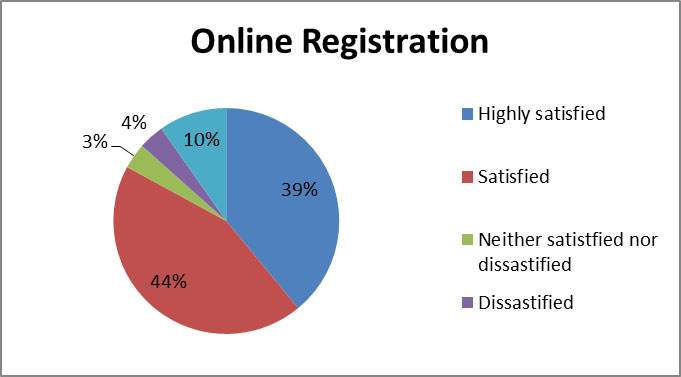
Image Description
The image above is a pie chart depicting the participants' satisfaction with the online registration process. 39% were “highly satisfied”, 44% were “satisfied”; 3% were “neither satisfied nor dissatisfied”; and 4% were “dissatisfied”. There's 10% for N/A, but there's no N/A in the legend.
The information available in advance of the 3rd Annual Round Table on Disaster Risk Reduction (online/email)
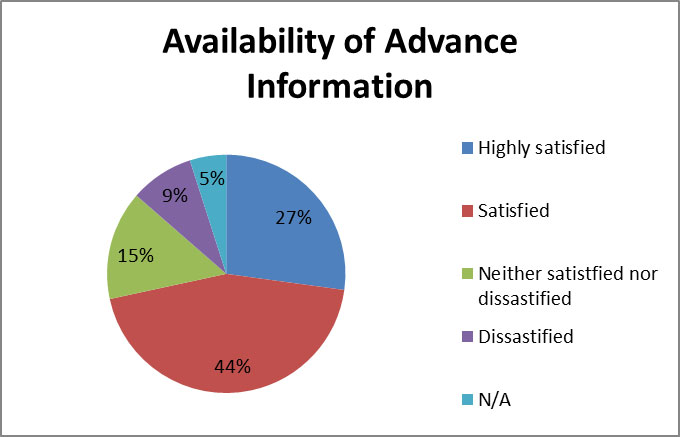
Image Description
The image above is a pie chart depicting the participants' satisfaction with the availability of advance information. 27% were “highly satisfied”, 44% were “satisfied”; 15% were “neither satisfied nor dissatisfied”, 9% were “dissatisfied”, and 5% were “N/A”.
The information provided in the participant handbook at the 3rd Annual Round Table on Disaster Risk Reduction
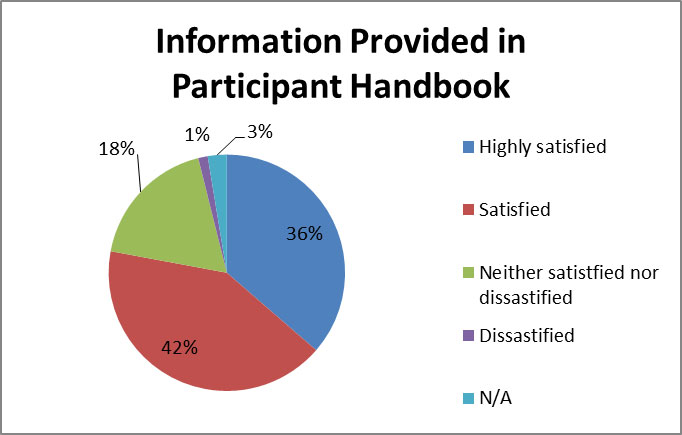
Image Description
The image above is a pie chart depicting the participants' satisfaction with the information provided in the Participant Handbook. 36% were “highly satisfied”, 42% were “satisfied”; 18% were “neither satisfied nor dissatisfied”; 1% were “dissatisfied”, and 3% were “N/A”. There's 10% for N/A, but there's no N/A in the legend.
The 3rd Annual Round Table on Disaster Risk Reduction as a forum to network with other persons engaged in disaster risk reduction
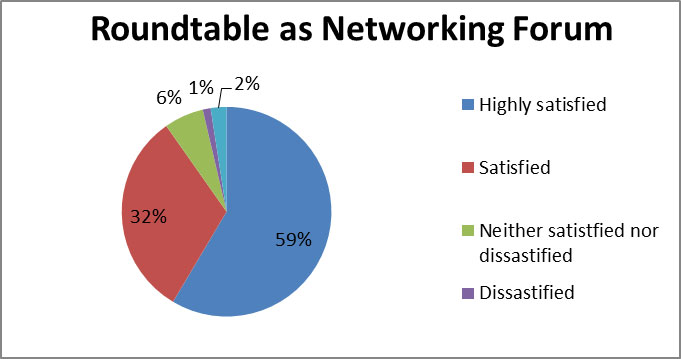
Image Description
The image above is a pie chart depicting the participants' satisfaction with the Roundtable as a networking forum. 59% were “highly satisfied”, 32% were “satisfied”; 6% were “neither satisfied nor dissatisfied”; 1% were “dissatisfied”, and 2% were “N/A”.
The 3rd Annual Round Table on Disaster Risk Reduction as a forum to enable an open dialogue on disaster risk reduction
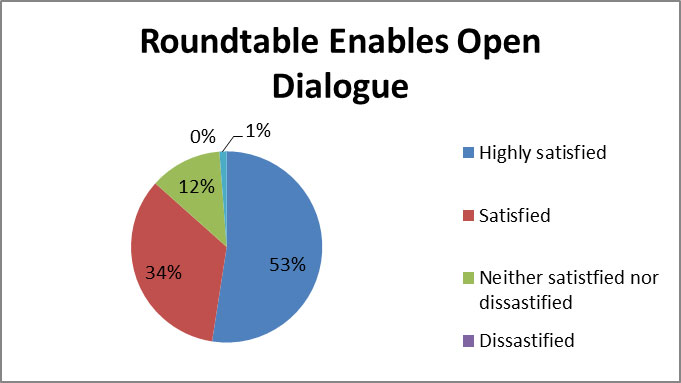
Image Description
The image above is a pie chart depicting the participants' satisfaction on how the Roundtable enables open dialogue. 53% were “highly satisfied”, 34% were “satisfied”; 12% were “neither satisfied nor dissatisfied”; and 0% were “dissatisfied”, and 1% were “N/A”.
The talk-show at the 3rd Annual Round Table on Disaster Risk Reduction
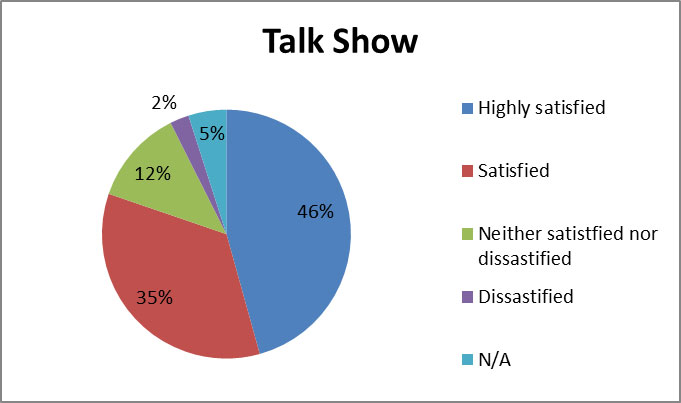
Image Description
The image above is a pie chart depicting the participants' satisfaction with the talk show component. 46% were “highly satisfied”, 35% were “satisfied”; 12% were “neither satisfied nor dissatisfied”; 2% were “dissatisfied”, and 5% were “N/A”.
The facilities used for hosting the 3rd Annual Round Table on Disaster Risk Reduction
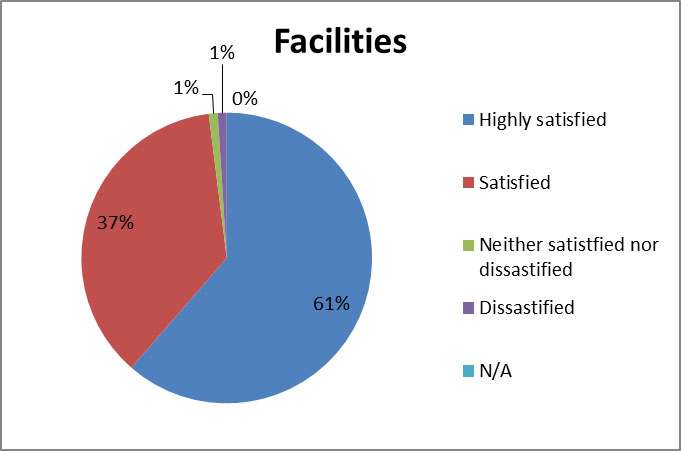
Image Description
The image above is a pie chart depicting the participants' satisfaction with the facilities. 61% were “highly satisfied”, 37% were “satisfied”; 1% were “neither satisfied nor dissatisfied”; and 1% were “dissatisfied”.
The instructions provided by the facilitators/hosts through-out the Roundtable
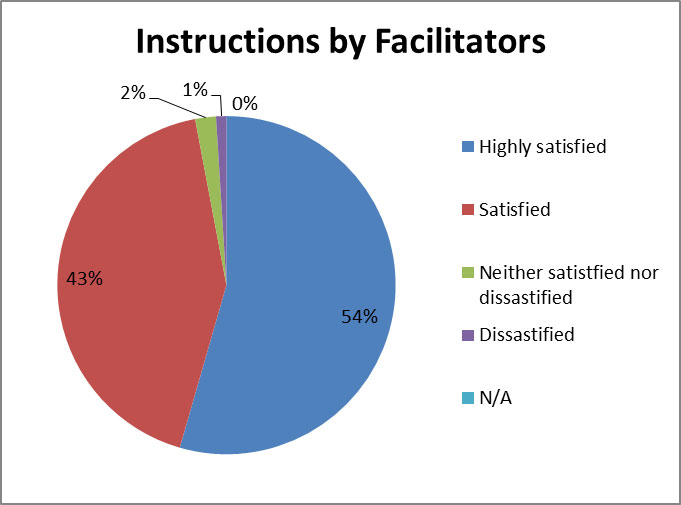
Image Description
The image above is a pie chart depicting the participants' satisfaction with the facilitators' instructions. 54% were “highly satisfied”, 43% were “satisfied”; 2% were “neither satisfied nor dissatisfied”; and 1% were “dissatisfied”.
The process used for engaging participants during the breakouts sessions

Image Description
The image above is a pie chart depicting the participants' satisfaction with the engagement process in the breakout sessions. 49% were “highly satisfied”, 46% were “satisfied”; 3% were “neither satisfied nor dissatisfied”; 1% were “dissatisfied”, and 1% was “N/A”.
The use of my time through-out the day
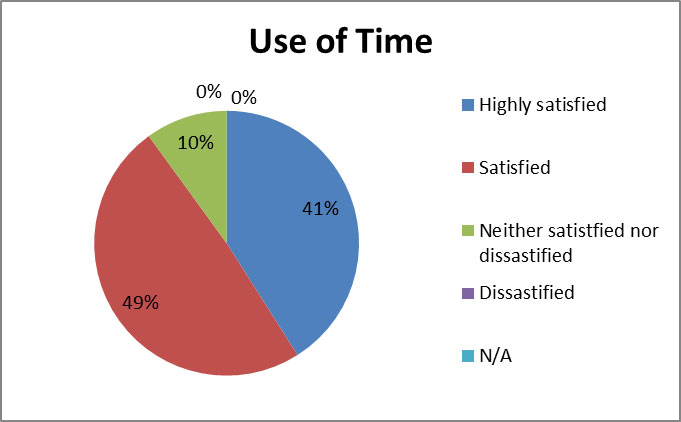
Image Description
The image above is a pie chart depicting the participants' satisfaction with their use of time throughout the day. 41% were “highly satisfied”, 49% were “satisfied”; and 10% were “neither satisfied nor dissatisfied”.
I am interested in engaging more actively on issues discussed at the 3rd Annual Round Table on Disaster Risk Reduction
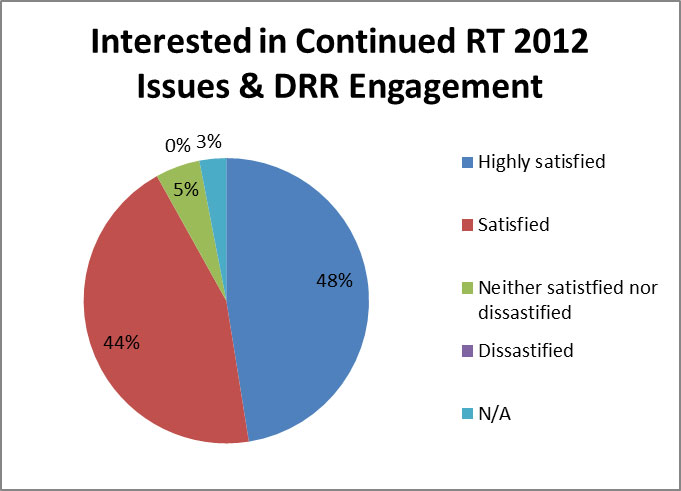
Image Description
The image above is a pie chart depicting the participants' level of interest in continued Roundtable 2012 issues and Disaster Risk Reduction engagement. 48% were “highly interested”, 44% were “interested”; 5% were “neither interested nor uninterested”; and 3% were “N/A”.
I would like to attend the next Annual Round Table on Disaster Risk Reduction event in 2013
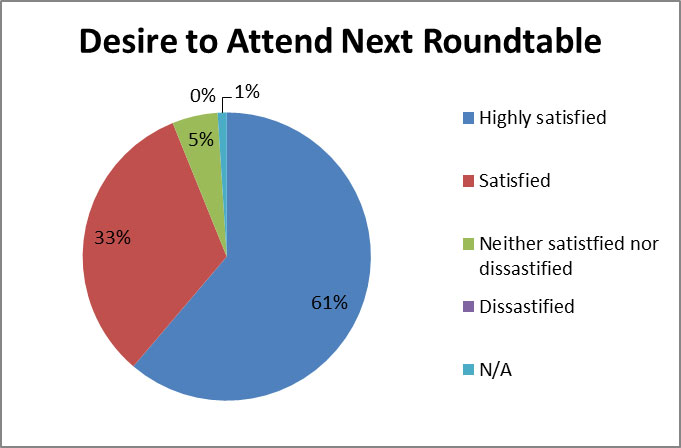
Image Description
The image above is a pie chart depicting the participants' desire to attend the next Roundtable. 61% reported “very strong”, 33% reported “strong”; 5% reported “neither strong nor weak”; 0% were “weak”, and 1% reported “N/A”.
- Date modified:
